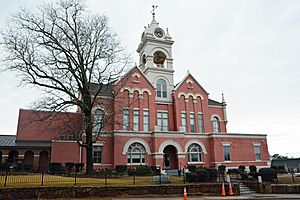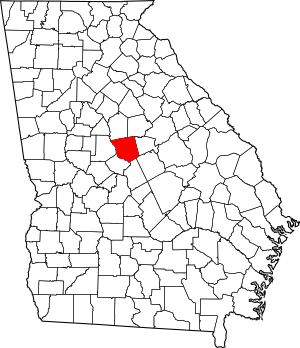Jones County, Georgia facts for kids
Quick facts for kids
Jones County
|
|
|---|---|

Jones County Courthouse in Gray
|
|

Location within the U.S. state of Georgia
|
|
 Georgia's location within the U.S. |
|
| Country | |
| State | |
| Founded | December 10, 1807 |
| Named for | James Jones |
| Seat | Gray |
| Largest city | Gray |
| Area | |
| • Total | 395 sq mi (1,020 km2) |
| • Land | 394 sq mi (1,020 km2) |
| • Water | 1.5 sq mi (4 km2) 0.4%% |
| Population
(2020)
|
|
| • Total | 28,347 |
| • Density | 72/sq mi (28/km2) |
| Time zone | UTC−5 (Eastern) |
| • Summer (DST) | UTC−4 (EDT) |
| Congressional district | 8th |
Jones County is a county located in the middle part of Georgia. In 2020, about 28,347 people lived there. The main town, or county seat, is Gray. Jones County was started on December 10, 1807. It was named after James Jones, who was a representative for Georgia in the U.S. government.
Contents
History
Jones County was created on December 10, 1807. It was formed from land that used to be part of Baldwin County. This land was also once part of the Creek Nation. Other counties like Morgan County and Putnam County were also created at the same time.
At first, a town called Albany was the county seat. Its exact location is not known today. It might have been renamed Clinton. Clinton officially became the county seat on December 22, 1808. It grew into an important center for trade and cotton in the 1800s. For a while, Clinton was one of Georgia's biggest cities.
Over time, Jones County's borders changed a bit. In 1810, it gained some land from Putnam County. In 1822, it lost some land when Bibb County was created.
In the early 1800s, many people moved to Jones County. Around 1835, the county was one of the richest in Georgia because of its farms. But after 1835, the soil became less fertile. Many farmers moved to new lands in other parts of Georgia.
The Civil War and Griswoldville
Before the American Civil War, a few factories opened in the county. One was a cotton gin factory in Griswoldville. Another was a woolen factory in Wallace. Samuel Griswold started Griswoldville in the 1850s.
During the Civil War, the Griswoldville factory started making weapons for the Confederate Army. Griswoldville was also on a railway line that connected Macon to Savannah. This made it an important target for the Union Army in 1864. On November 20, 1864, the town and its factories were burned. This happened during Sherman's March to the Sea. A few days later, the Battle of Griswoldville took place nearby. The town of Griswoldville was never rebuilt.
Many other areas in Jones County were also damaged during the Civil War. The Jarrell Plantation State Historic Site is in Jones County. It shows what a well-preserved plantation from before the war looked like.
Moving the County Seat
In the 1890s, a new railroad line was built through the county. It bypassed Clinton because citizens did not want the train to go through their town. By the early 1900s, more people lived in the northeast part of the county. The city of Gray was established there.
On June 27, 1905, the people of Jones County voted to move the county seat. Most people, 1,289 votes, wanted to move it to Gray. Only 51 votes were for keeping it in Clinton. So, on August 9, 1905, Gray became the new county seat of Jones County.
Geography
The U.S. Census Bureau says that Jones County covers about 395 square miles. Most of this, about 394 square miles, is land. Only about 1.5 square miles (0.4%) is water.
The western part of Jones County, west of Gray, is in the Upper Ocmulgee River area. The northeastern part, north of Gray, is in the Upper Oconee River area. The southeastern corner is in the Lower Oconee River area. All these rivers are part of the larger Altamaha River system.
Major highways
Rivers
Adjacent counties
Jones County shares borders with these other counties:
- Jasper County - to the north
- Putnam County - to the northeast
- Baldwin County - to the east
- Twiggs County - to the southeast
- Wilkinson County - to the southeast
- Bibb County - to the south
- Monroe County - to the west
National protected areas
Parts of these protected areas are in Jones County:
- Oconee National Forest
- Piedmont National Wildlife Refuge
Communities
Demographics
| Historical population | |||
|---|---|---|---|
| Census | Pop. | %± | |
| 1810 | 8,597 | — | |
| 1820 | 16,570 | 92.7% | |
| 1830 | 13,345 | −19.5% | |
| 1840 | 10,065 | −24.6% | |
| 1850 | 10,224 | 1.6% | |
| 1860 | 9,107 | −10.9% | |
| 1870 | 9,436 | 3.6% | |
| 1880 | 11,613 | 23.1% | |
| 1890 | 12,709 | 9.4% | |
| 1900 | 13,358 | 5.1% | |
| 1910 | 13,103 | −1.9% | |
| 1920 | 13,269 | 1.3% | |
| 1930 | 8,992 | −32.2% | |
| 1940 | 8,331 | −7.4% | |
| 1950 | 7,538 | −9.5% | |
| 1960 | 8,468 | 12.3% | |
| 1970 | 12,218 | 44.3% | |
| 1980 | 16,579 | 35.7% | |
| 1990 | 20,739 | 25.1% | |
| 2000 | 23,639 | 14.0% | |
| 2010 | 28,669 | 21.3% | |
| 2020 | 28,347 | −1.1% | |
| 2023 (est.) | 28,969 | 1.0% | |
| U.S. Decennial Census 1790-1880 1890-1910 1920-1930 1930-1940 1940-1950 1960-1980 1980-2000 2010 |
|||
| Group | Number | Percent |
|---|---|---|
| White (not Hispanic) | 20,074 | 70.82% |
| Black or African American (not Hispanic) | 6,739 | 23.77% |
| Native American | 46 | 0.16% |
| Asian | 138 | 0.49% |
| Pacific Islander | 7 | 0.02% |
| Other/mixed | 867 | 3.06% |
| Hispanic or Latino | 476 | 1.68% |
In 2020, there were 28,347 people living in Jones County. There were 10,701 households and 7,670 families.
Education
Jones County has its own school system that serves the students in the area.
Notable people
Many interesting people have connections to Jones County:
- Terrance Gore: A professional baseball player who has played for teams like the Kansas City Royals and Atlanta Braves. He was part of World Series winning teams in 2015 and 2021.
- William Lee: An early politician in Alabama who moved to Jones County from England.
- Sadie Gray Mays: Born in Gray in 1900, she was a social worker and the wife of college president Benjamin Mays.
- Otis Redding: A famous singer who owned a ranch in Jones County. There is a marker in downtown Gray that honors him.
- John T. Edge: A writer and director of the Southern Foodways Alliance. He hosts the TV show True South and writes books about Southern food.
See also
 In Spanish: Condado de Jones (Georgia) para niños
In Spanish: Condado de Jones (Georgia) para niños

